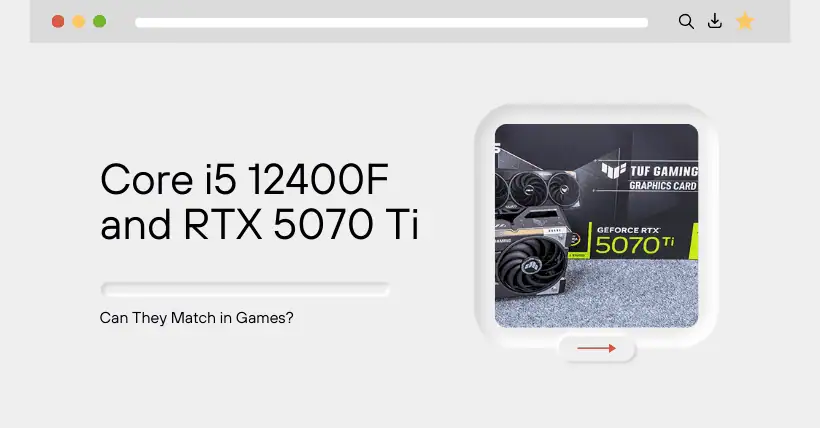I. Introduction
The Core i5-12400F is a cost-effective entry-level processor, and some users in this category may be considering upgrading their graphics card. This article will test the gaming performance of the Core i5-12400F paired with the GeForce RTX 5070 Ti.
The significance of this test is as follows: If the Core i5-12400F paired with the GeForce RTX 5070 Ti does not encounter any performance bottlenecks and the graphics card’s performance can be fully utilized, then all processors with higher performance than the Core i5-12400F should have no issues. Conversely, if this configuration shows noticeable performance bottlenecks and the graphics card’s performance is generally underutilized, it would indicate that processors with lower performance than the Core i5-12400F would also struggle. Therefore, this test is highly valuable for reference.
II. Specifications Overview
The Core i5-12400F uses a 10nm process, featuring 6 large cores and no small cores, with a total of 12 threads. Its base clock is 2.5 GHz, with a maximum boost clock of 4.4 GHz. It has 7.5MB of L2 cache and 18MB of smart cache. The thermal design power (TDP) is 65W, and the suggested retail price is $174.
The GeForce RTX 5070 Ti was released on January 6, 2025, featuring the GB203 GPU chip, manufactured using TSMC’s 5nm process. It has 8,960 CUDA cores, 280 texture units, 70 multiprocessor streaming processors, 280 tensor cores, and 70 ray tracing cores.
The L2 cache is 64MB, with a base clock of 2300MHz and a boost clock of 2452MHz. It is equipped with 16GB of GDDR7 video memory, a 256-bit memory bus, a memory speed of 28Gbps, and a memory bandwidth of 896GB/s. The FP32 floating-point performance is 43.94 T FLOPS, and the power consumption is 300W, with a reference price of $749.
III. Test Platform Configuration (Core i5 12400F and RTX 5070 Ti)
The main configuration is as follows:
Processor: Core i5-12400F
Motherboard: Gigabyte Z790 Gaming X AX
Memory: 32GB DDR5 6000MHz
Graphics Card: GeForce RTX 5070 Ti
Storage: ADATA XPG S40G 512GB RGB
Operating System: Windows 10
IV. Game Tests
The following tests will cover seven games, all run at 1080P with the highest graphical settings.
The first game is Alan Wake 2.
The average frame rate is 110 FPS, with a minimum frame rate of 71 FPS, and a frame time of 9.2ms. The CPU usage is 35%, with a power consumption of 47W, and a temperature of 53°C. Memory usage is 10.7GB, while GPU usage is 98%, with a VRAM usage of 9.3GB, and the GPU power consumption is 245W with a temperature of 61°C.
In this game, the CPU usage is around 35%, which is relatively light. Memory usage fluctuates between 10GB and 11GB. The GPU is nearly fully utilized, with VRAM usage slightly above 9GB.
The average frame rate is around 110 FPS, with the minimum frame rate staying above 70 FPS and a frame time around 9ms, showcasing strong GPU performance.
The second game is Marvel’s Spider-Man 2.
The average frame rate is 105 FPS, with a minimum frame rate of 60 FPS, and a frame time of 9.0ms. CPU usage is 71%, power consumption is 65W, and the temperature is 60°C. Memory usage is 14.6GB, with GPU usage at 67%, and VRAM usage is 10.0GB. The GPU power consumption is 156W, and the temperature is 55°C.
In this game, CPU usage is around 70%, which is relatively high. Memory usage is between 14GB and 15GB. GPU usage is less than 70%, and VRAM usage exceeds 10GB.
The average frame rate exceeds 100 FPS, with the minimum frame rate staying around 60 FPS and a frame time around 9ms. However, the GPU performance is not fully utilized.
The third game is Cyberpunk 2077.
The average frame rate is 78 FPS, with a minimum frame rate of 54 FPS, and a frame time of 10.0ms. CPU usage is 70%, power consumption is 61W, and the temperature is 63°C. Memory usage is 11.8GB, with GPU usage at 92%, and VRAM usage is 9.5GB. The GPU power consumption is 260W, and the temperature is 62°C.
In this game, CPU usage is also around 70%, which is quite high. Memory usage fluctuates between 11GB and 12GB. There is still some unused GPU power, and VRAM usage ranges from 9GB to 10GB.
The average frame rate stays above 70 FPS, with the minimum frame rate above 50 FPS and a frame time around 10ms, though the GPU’s full potential is not reached.
The fourth game is Monster Hunter: World.
The average frame rate is 63 FPS, with a minimum frame rate of 38 FPS, and a frame time of 21.3ms. CPU usage is 68%, power consumption is 61W, and the temperature is 60°C. Memory usage is 18.2GB, with GPU usage at 88%, and VRAM usage is 11.5GB. The GPU power consumption is 180W, and the temperature is 55°C.
In this game, CPU usage is also around 70%, which is relatively high. Memory usage exceeds 18GB. There is still about 10% unused GPU power, with VRAM usage between 11GB and 12GB.
The average frame rate is above 60 FPS, with the minimum frame rate exceeding 30 FPS and a frame time around 21ms, resulting in noticeable lag and underutilized GPU performance.
The fifth game is Stalker 2.
The average frame rate is 71 FPS, with a minimum frame rate of 35 FPS, and a frame time of 15.9ms. CPU usage is 73%, power consumption is 66W, and the temperature is 64°C. Memory usage is 18.1GB, with GPU usage at 75%, and VRAM usage is 8.2GB. The GPU power consumption is 164W, and the temperature is 55°C.
In this game, CPU usage exceeds 70%, which is high. Memory usage is around 18GB. There is still 25% unused GPU power, with VRAM usage just above 8GB.
The average frame rate is around 71 FPS, with the minimum frame rate exceeding 30 FPS and a frame time around 15ms, showing underutilized GPU performance.
The sixth game is Black Myth: Wukong.
The average frame rate is 85 FPS, with a minimum frame rate of 63 FPS, and a frame time of 11.4ms. CPU usage is 39%, power consumption is 50W, and the temperature is 57°C. Memory usage is 14.7GB, with GPU usage at 98%, and VRAM usage is 7.4GB. The GPU power consumption is 225W, and the temperature is 59°C.
In this game, CPU usage is only around 40%, which is light. Memory usage fluctuates between 14GB and 15GB. The GPU is nearly fully utilized, with VRAM usage just over 7GB.
The average frame rate exceeds 80 FPS, with the minimum frame rate exceeding 60 FPS and a frame time around 11ms, demonstrating fully utilized GPU performance.
The seventh game is The Last of Us Part I.
The average frame rate is 87 FPS, with a minimum frame rate of 60 FPS, and a frame time of 11.2ms. CPU usage is 70%, power consumption is 58W, and the temperature is 59°C. Memory usage is 15.9GB, with GPU usage at 99%, and VRAM usage is 9.8GB. The GPU power consumption is 228W, and the temperature is 59°C.
In this game, CPU usage is around 70%, which is relatively high. Memory usage fluctuates between 15GB and 16GB. The GPU is nearly fully utilized, with VRAM usage around 10GB.
The average frame rate exceeds 80 FPS, with the minimum frame rate around 60 FPS and a frame time around 11ms, indicating fully utilized GPU performance.
V. Test Conclusion
Overall, the Core i5-12400F paired with the GeForce RTX 5070 Ti shows no significant performance bottlenecks. In most games, the GPU usage can reach over 90%, though the CPU load is generally high.
In conclusion, while there are no major bottlenecks with this combination, it is somewhat strained and strongly not recommended. If you are currently using a Core i5-12400F, it is not advisable to pair it with the GeForce RTX 5070 Ti. If you plan to get the GeForce RTX 5070 Ti, the processor should at least be one tier higher.

Disclaimer:
- This channel does not make any representations or warranties regarding the availability, accuracy, timeliness, effectiveness, or completeness of any information posted. It hereby disclaims any liability or consequences arising from the use of the information.
- This channel is non-commercial and non-profit. The re-posted content does not signify endorsement of its views or responsibility for its authenticity. It does not intend to constitute any other guidance. This channel is not liable for any inaccuracies or errors in the re-posted or published information, directly or indirectly.
- Some data, materials, text, images, etc., used in this channel are sourced from the internet, and all reposts are duly credited to their sources. If you discover any work that infringes on your intellectual property rights or personal legal interests, please contact us, and we will promptly modify or remove it.








